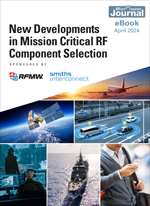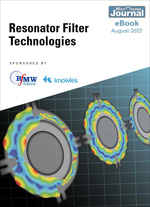Please note:
By downloading an eBook, the details of your profile will be shared with the sponsoring company and you may be contacted by them directly.
New Developments in Mission Critical RF Component Selection
Mission-critical RF component selection has experienced remarkable advancements with breakthroughs in materials science, semiconductor technology, and design methodologies. These innovations have paved the way for the development of components capable of operating under extreme conditions, delivering unparalleled performance, and ensuring seamless interoperability within complex communication infrastructures. This eBook covers new developments in SDRs, filter topologies, semi-rigid cable assemblies, RF over fiber and a modular approach to phased arrays. These new developments will assist the design engineer in some new approaches to RF component selection for mission critical applications.
Direct Data Conversion for Multi-band and Multi-Services Systems
This eBook addresses some of the challenges and considerations when developing architectures and components to support these new multi-band, multi-services capabilities. The first article gives a good overview of multi-band microwave direct access using synthetic aperture radars using earth observation applications as an illustration. Articles two through four address how direct data converters and other components are enabling software satellites and other multi-band, multi-services transceivers. The final two articles explore using data converters and signal processing, in conjunction with optical interconnects to replace copper in the transport layer. We hope that this eBook gives you a good overview of the possibilities that can be enabled by high performance, direct access, multi-band, multi-services networks.
RF Technology Trends for LEO Satellite Systems
The New Space market is growing fast, and LEO Satellite Systems require the latest RF technology for communications and data transmission. This eBook covers the latest in LEO constellations and RF technology for power amplifier and components. The first two articles cover Ka-Band amplifiers and how GaN is changing the RF front end. GaN technology offers more efficient power solutions, opening up new ways to configure systems to reduce power consumption and heat dissipation. Other articles review the broadband satellite market, GlobalStar LEO Satellite System, Kuiper’s terminals, and the use of COTS components for Space applications.
5G Satellite Communications Market and Design Trends
With direct-to-satellite connectivity, unmodified cellular smartphones and IoT devices can now leverage satellite communications networks. These new capabilities will meet the needs of many applications for connectivity in remote areas where cellular service is unavailable while supplementing them in areas with cellular service already available. This eBook looks at various satellite communications trends along with the challenges and solutions related to device and system simulation and testing for these markets. Keysight Technologies, the sponsor of this eBook, presents end-to-end capabilities for testing and evaluating devices, subsystems, and systems for the growing satellite market.
Configurable Power Management Solutions for RF and Wireless
Qorvo has long been known for its RF capabilities, particularly its strength in power amplifiers based on GaN technology, which provides higher power density with high efficiency. Traditionally, RFIC companies haven’t worried about how their semiconductor components are biased, specifying a voltage and current in the data sheet and leaving procurement of the power supply to their customers. Yet the performance of the power supply affects the overall performance of the system: size, weight, efficiency, noise. So, it was logical that Qorvo expanded its product strategy to include power management. This eBook surveys Qorvo’s expanded portfolio for high performance analog applications.
Resonator Filter Technologies
This eBook explores advancements in the design of filters and resonator technologies. The first article illustrates how EM simulation has significantly improved the development of complex filters. The article illustrates the process with the design of a 75 Ω filter covering 564 to 1200 MHz for a cable TV distribution system. The second article continues the design discussion using a bandpass filter for 5G band n257. The next article describes an innovative evolution of YIG resonators — reducing power consumption, size and cost — and its application to tunable filters. The article discusses the evolution of the YIG and how one company is applying this improved capability to tunable filters operating above 2 GHz. Read this to learn more about these topics.
Innovations in Passive Device Design to Reduce SWaP
This eBook explores how passive components are contributing to the progress of reducing SWaP, complementing semiconductor integration. Topics covered include reducing RF Circuit SWaP with high K materials and precision thin-film microstrip technology; filter technology options for mmWave applications; compact, low loss switched filter bank using MEMS switches; and using additive manufacturing for Aerospace and Defense components including examples of antennas, amplifiers and filters.
New Developments in Additive Manufacturing for RF/Microwave Applications
Additive Manufacturing and 3D printing have evolved quickly over the last few years and made its way into the RF and microwave market. We have seen everything from 3D printed PCBs and circuits to waveguides to antennas and lenses to connectors. Additive manufacturing has the advantages of being able to produce shapes that are not possible with traditional manufacturing techniques and able to miniaturize structures which is well suited for higher frequencies. They also use less material and in many cases are lighter than traditional manufactured parts. Additive manufactured parts can typically be produced much faster than traditional techniques for smaller quantities and fast prototypes. The eBook covers many of the recent innovative devices and components that additive manufacturing and 3D printing have enabled in the RF and microwave space. The articles cover 3D printed PCB circuits, antennas, coaxial SMA-to-waveguide transitions, copper and air dielectric routing circuits, filters, and waveguides.
mmWave Technologies and Product Innovations
mmWave is the industry’s newest frontier, a free space resource that has triggered a “gold rush” of technology horses and applications riding them. This eBook samples a few of these applications and the challenges facing them. The first article, “Using E-Band for Wideband SatCom: Opportunities and Challenges,” contributed by Hughes Network Systems, describes the requirements for and challenges with E-Band links between the earth and geostationary satellites. The new article “Virtual Cable Calibration for OTA Testing of 5G mmWave Devices” by Rohde & Schwarz describes the concept and how it is used to ensure compliance to the 3GPP standards. The article “6G: Innovating the Future of Wireless Communications,” submitted by Keysight Technologies, surveys a few of the use cases being discussed and the consortiums formed to explore them. Wide bandwidth at sub-THz frequencies is a shared theme. “Satcom, the New mmWave Frontier,” also contributed by Keysight Technologies, returns to mmWave satellite links, specifically the difficulty making accurate and repeatable measurements, particularly OTA. The article “5G Fixed Wireless Access Array and RF Front-End Trade-Offs,” contributed by Qorvo, outlines the design of a fixed wireless access system for a suburban neighborhood, including the design of the phased array and trade-offs among the semiconductor technology options for the front-end module. Concluding the eBook, an article from Qorvo discusses phase noise, an important parameter that can limit the data rate of communications systems.
RF & Microwave Components for SatCom Applications
Whether prompted by the convenience of small size, the fuel savings from lighter weight or the smaller wavelengths of higher frequencies, size is on an inexorable decline. Moore’s Law is the archetype defining the shrinking of semiconductor technology, yet it would not be possible without other components following the same trend, particularly the passive devices that filter and route the signals processed by the ICs. This eBook compiled by Knowles explores some of the market and technology trends driving the demand for higher frequencies and smaller size. Beginning with an overview of the classic Wilkinson power divider and combiner designs, it also covers various other SATCOM related component technologies ranging from PCBs to high speed converters to phased arrays plus test challenges in this area.
D esign Considerations for High Reliability RF PCB Circuit Designs for Extreme Environments
esign Considerations for High Reliability RF PCB Circuit Designs for Extreme Environments
This eBook addresses many design issues with PCBs for high power GaN devices, higher frequency mmWave circuits, thermal expansion effects, heat sinking, extending operating temperatures, reducing circuit size, copper surface roughness effects, interface materials and connector launch methods. The first two articles deal with high power GaN devices addressing some of the design challenges for high voltage and high frequency designs. The next article looks at PCB materials to reduce circuit size and the one after addresses thermal power handling in space applications. The next article looks at environmental effects on circuit performance and how to test them while the last two articles address designing PCB mmWave circuits including amplifiers.
New Developments in SATCOM Amplifiers and Antennas
This eBook covers new RF design techniques being used in the area of SATCOM. It starts off with an overview of defense technologies by Strategy Analytics followed by two articles on the design of GaN amplifiers for SATCOM including new GaN-on-diamond amplifiers and another on space qualified GaN amplifiers. And the final article takes a look at new antenna technologies that promise great improvements for SATCOM and other applications. Read this eBook to learn about these new trends in SATCOM design.
SATCOM GaN Power Amplifier Design
The first article in this eBook is written by Strategy Analytics’ Asif Anwar covering the military satellite terminal basics, market trends and the outlook for this market. With a major shift from GaAs to GaN as the semiconductor device material of choice, Norsat compares the two technologies covering the reasons for this shift and the advantages of GaN technology for SATCOM amplifiers. Another article covers the design of a broadband, highly efficient, GaN power amplifier. The last article reviews GaN SSPA technology for space-based applications covering the challenges to device design and reliability as they start to replace TWTs in this area. Read this eBook to learn about these important topics in SATCOM amplifiers.
GPS/GNSS Interference Challenges and Solutions
With the expansion of GNSS/GPS systems worldwide, this eBook addresses the critical interference issues covering filter design, co-existence of systems, system architecture, testing, temperature considerations and more in the successful design of GNSS/GPS systems for today’s wireless applications. It also offers insight into basic filter design in systems and filter design trends in the market.













